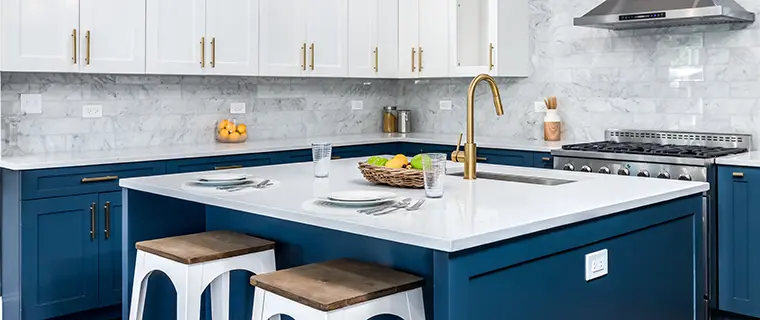Homeowners who want to tackle major home renovations or consolidate high-interest debt can tap into their home’s equity and take out a home equity line of credit (HELOC). Unlike home equity loans, which offer a lump sum, HELOCs are a revolving line of credit. You can borrow funds whenever you need them, like a credit card. You’re given a maximum credit limit based on appraised value of your home and current mortgage balance, typically up to 85% of your home’s value minus any remaining mortgage payments. If you’re considering borrowing against your home’s equity, check out the pros and cons of a HELOC and see if it’s the right choice for your financial situation.
Pros of a HELOC
Little to no closing costs
Closing costs for HELOCs are lower than what it costs to close a mortgage, as loan sizes for HELOCs are smaller than a standard mortgage. Closing costs for HELOCs typically run between 2% to 5% of the total line of credit and consist of origination fees, underwriting fees, and other administration fees. Depending on your lender, some of these costs are reduced or eliminated. For example, some lenders may waive origination fees or offer no cash due at closing.
Lower interest rates and tax benefits1
HELOC rates are often lower than other credit lines, like personal loans and credit cards. Interest rates for personal loans range from 6% to 36% depending on credit score and financial history, and credit cards average around 21%. Meanwhile, some of the best HELOC rates fall around 6%. Interest may be eligible for a tax deduction1, but there are restrictions depending on the use of funds for home improvements or renovations. The Tax Cuts and Job Act of 2017 made several changes to individual income tax, including reforms on itemized deductions. But interest paid on HELOCs can be deducted only if the loan makes improvements on the taxpayer’s home used as collateral, and it must be their main home. Interest isn’t tax-deductible when used to pay off personal living expenses, like credit card debt.
Financial flexibility
HELOCs offer tons of financial flexibility. Depending on the amount borrowed, HELOC repayment periods are often longer, allowing flexibility in managing monthly payments, which makes them ideal for big-ticket projects or expenses. The timeline varies, but some lenders offer terms up to 30 years. You also only pay interest during the HELOC draw period, which is usually the first five to 10 years of the loan’s lifetime. When the draw period ends, you start making payments on principal and interest. You have the option to pay the principal amount, too, to lower the amount remaining during the repayment period.
Fewer restrictions on how you use funds
There aren’t many restrictions on how you can use HELOC funds, but most people use HELOCs to pay for major renovations. Even though HELOCs are secured by your home, you don’t have to use them for remodeling. Sometimes, it can be beneficial to use HELOCs to pay off personal expenses because of their lower interest rates. For example, HELOCs can be used to consolidate debt, pay off substantial medical expenses, or help pay for tuition, to name a few.
Cons of a HELOC
Your home is collateral
Unlike credit cards or personal loans, which are unsecured, HELOCs are secured loans, which means a form of collateral is required to borrow funds. Secured loans often have lower interest rates but assume some risk. The upside of your home being used as collateral is that the more equity you’ve built, the more you’re capable of borrowing. The downside of your home as collateral is if you’ve missed a few loan repayments, unfortunately, your home could be subject to foreclosure.
Your home’s equity is reduced
As previously mentioned, HELOCs involve borrowing against your home’s equity, which impacts your overall property values and appraised value over time. When you build equity and can borrow what you need, it’s beneficial. However, if housing prices decrease and the value of your home drops, this could lead to you owing more than what your home’s worth. And, if you owe more than what your home is worth, this reduces your borrowing capability.
Variable interest rates
Unlike home equity loans, which offer fixed interest rates, HELOCs offer variable interest rates. The interest rate fluctuates over time—usually at the mercy of the Federal Reserve. The Federal Reserve is responsible for setting the rates that credit unions and banks charge each other for overnight loans to meet reserve requirements. The prime rate is another benchmark rate and the most used determining factor of HELOC rates. The prime rate is typically 3% higher than the federal fund rate, and lenders use this to set their rates. When the Federal Reserve changes the federal funds rate, other loan rates increase or decrease.
How to handle rate fluctuations
Because HELOCs have variable interest rates, borrowers should be prepared for potential rate fluctuations over time. While lower rates can mean affordable monthly payments, rising rates can increase your costs. Here’s how you can manage these fluctuations effectively:
- Set aside extra funds during low-rate periods
- Explore fixed-rate conversion options
- Talk to a financial advisor
When interest rates are low, your monthly payment will be lower, which gives you an opportunity to save. Consider setting aside the difference between your current payment and what it might be at a higher rate. This cushion can help cover future increases and prevent strain on your budget.
Some lenders offer the ability to convert a portion of your HELOC into a fixed-rate loan. If you’re worried about rising rates, check with your lender to see if this option is available. Locking in a fixed rate on a portion of your balance can provide stability and predictability in your payments.
A financial advisor can help you develop a strategy for managing your HELOC based on your overall financial situation and goals. They can offer insight into interest rate trends, repayment strategies, and whether refinancing into a different loan product might be a good option for you
Possibility of overspending
Unfortunately, HELOCs aren’t interest-only payments forever. During the draw period, you’re required to make interest payments. It can be easy to lose track of your HELOC balance and forget how much you owe, especially when you have a draw period of 10 years. When the draw period’s over, you begin paying the principal amount of your loan, plus interest. If you’re not anticipating or accounting for the increase in monthly payments when your draw period ends, it can come as a financial shock.
Comparing HELOCs to other borrowing options
When you’re considering a HELOC, it’s helpful to know your other borrowing options, too, like personal loans, cash-out refinancing, or credit cards. Each has its own advantages and works for different situations.
Comparing HELOCs to Other Borrowing Options |
||
|---|---|---|
| Loan Type | Key Features | Best For |
| HELOC | Variable interest rate, revolving credit line, uses home as collateral | Ongoing expenses like home renovations, debt consolidation, or covering unpredictable costs |
| Personal loan | Fixed interest rate, lump-sum disbursement, no collateral required | One-time expenses such as medical bills or weddings, or consolidating high-interest debt without using your home as collateral |
| Cash-out refinance | Replaces existing mortgage with a new one, provides a lump sum based on home equity, typically lower interest rates than personal loans | Large expenses like major home improvements or consolidating higher-interest debt with a long repayment term |
| Credit card | High interest rates, revolving credit, may offer low-rate promotional period | Short-term expenses or emergencies, especially when a 0% APR promotional period is available |
Choosing the right option
- Choose a HELOC if you have equity in your home, need flexible access to funds, and are comfortable with a variable interest rate.
- Opt for a personal loan if you need a fixed repayment plan and don’t want to use your home as collateral.
- Consider a cash-out refinance if you want to take advantage of lower mortgage rates and access a lump sum for major expenses.
- Use a credit card for smaller, short-term expenses, especially if you can pay off the balance before interest accrues.
When a HELOC fits your goals (or doesn’t)
HELOCs can be a great tool, but they’re not the right choice for every situation. Here’s a few situations for when a HELOC makes sense and when it might not.
1. Home improvements
When it fits: A HELOC is ideal for home renovations, especially if you plan to complete projects over time. Since it’s a revolving line of credit, you can borrow what you need and only pay interest on what you use. For example, if you’re remodeling your kitchen and later decide to update your bathroom, a HELOC lets you fund both without taking out separate loans.
When it doesn’t: If you need a fixed amount for a single project, a home equity loan or cash-out refinance with a set repayment plan might be a better choice.
2. Debt consolidation
When it fits: A HELOC can help consolidate high-interest debt, like credit card balances, into a lower-interest option. If you have $20,000 in credit card debt with a 20% interest rate, using a HELOC with a lower rate can reduce your monthly payments and total interest costs.
When it doesn’t: If you struggle with managing debt or are likely to continue using credit cards after consolidating, a HELOC might not be the best long-term solution. You could risk accumulating more debt while also tying your home to your repayment obligations.
3. Emergency fund
When it fits: A HELOC can be a financial safety net for unexpected expenses, like medical bills or unexpected home repairs. Since you don’t have to use the funds immediately, it can give you peace of mind knowing you have access to cash if needed.
When it doesn’t: If you frequently rely on a HELOC for emergencies, you may end up in a cycle of debt. It’s better to build a dedicated emergency fund with savings rather than depending on borrowed money tied to your home.
Key takeaways:
- HELOCs offer lower interest rates than other credit lines, like personal loans and credit cards, plus offer a ton of flexibility in how you can use the funds.
- HELOCs are secured loans and require your home to be used as collateral, and they offer variable interest rates, so your monthly payment can change.
- HELOCs are great for home renovations that you plan to complete over time or for consolidating high-interest debt.
Although it involves significant consideration, HELOCs can be a viable option if you have enough equity built in your home due to their flexibility and potential tax benefits. But, using your home as collateral can be intimidating. Examine your financial goals and debt-to-income ratio and see if a HELOC works for your situation. And remember, we’re here for your lending needs with competitive ReadiEquity LOC rates.2






At this time what are the interests rates on a Heloc
Frank — You can view our home equity rates by clicking here or visiting georgiasown.org/rates-home-equity.